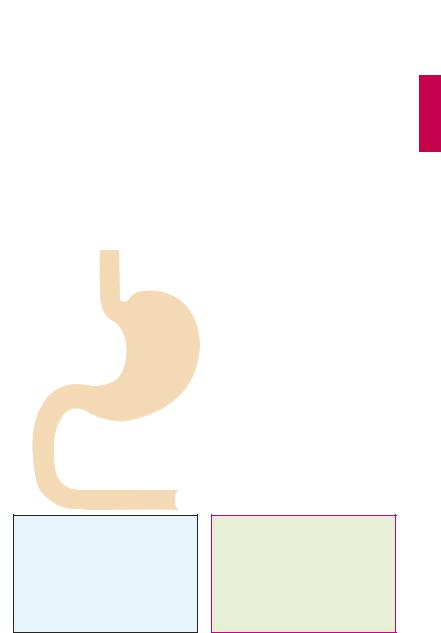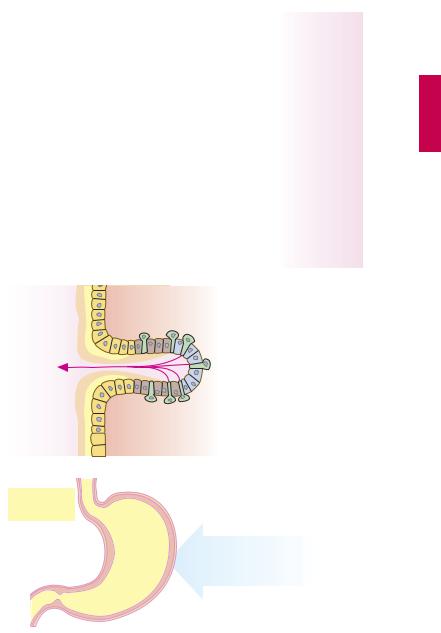
- •Preface to the 3rd edition
- •General Pharmacology
- •Systems Pharmacology
- •Therapy of Selected Diseases
- •Subject Index
- •Abbreviations
- •General Pharmacology
- •History of Pharmacology
- •Drug and Active Principle
- •The Aims of Isolating Active Principles
- •European Plants as Sources of Effective Medicines
- •Drug Development
- •Congeneric Drugs and Name Diversity
- •Oral Dosage Forms
- •Drug Administration by Inhalation
- •Dermatological Agents
- •From Application to Distribution in the Body
- •Potential Targets of Drug Action
- •External Barriers of the Body
- •Blood–Tissue Barriers
- •Membrane Permeation
- •Binding to Plasma Proteins
- •The Liver as an Excretory Organ
- •Biotransformation of Drugs
- •Drug Metabolism by Cytochrome P450
- •The Kidney as an Excretory Organ
- •Presystemic Elimination
- •Drug Concentration in the Body as a Function of Time—First Order (Exponential) Rate Processes
- •Time Course of Drug Concentration in Plasma
- •Time Course of Drug Plasma Levels during Repeated Dosing (A)
- •Time Course of Drug Plasma Levels during Irregular Intake (B)
- •Accumulation: Dose, Dose Interval, and Plasma Level Fluctuation (A)
- •Dose–Response Relationship
- •Concentration–Effect Curves (B)
- •Concentration–Binding Curves
- •Types of Binding Forces
- •Agonists—Antagonists
- •Other Forms of Antagonism
- •Enantioselectivity of Drug Action
- •Receptor Types
- •Undesirable Drug Effects, Side Effects
- •Drug Allergy
- •Cutaneous Reactions
- •Drug Toxicity in Pregnancy and Lactation
- •Pharmacogenetics
- •Placebo (A)
- •Systems Pharmacology
- •Sympathetic Nervous System
- •Structure of the Sympathetic Nervous System
- •Adrenergic Synapse
- •Adrenoceptor Subtypes and Catecholamine Actions
- •Smooth Muscle Effects
- •Cardiostimulation
- •Metabolic Effects
- •Structure–Activity Relationships of Sympathomimetics
- •Indirect Sympathomimetics
- •Types of
- •Antiadrenergics
- •Parasympathetic Nervous System
- •Cholinergic Synapse
- •Parasympathomimetics
- •Parasympatholytics
- •Actions of Nicotine
- •Localization of Nicotinic ACh Receptors
- •Effects of Nicotine on Body Function
- •Aids for Smoking Cessation
- •Consequences of Tobacco Smoking
- •Dopamine
- •Histamine Effects and Their Pharmacological Properties
- •Serotonin
- •Vasodilators—Overview
- •Organic Nitrates
- •Calcium Antagonists
- •ACE Inhibitors
- •Drugs Used to Influence Smooth Muscle Organs
- •Cardiac Drugs
- •Cardiac Glycosides
- •Antiarrhythmic Drugs
- •Iron Compounds
- •Prophylaxis and Therapy of Thromboses
- •Possibilities for Interference (B)
- •Heparin (A)
- •Hirudin and Derivatives (B)
- •Fibrinolytics
- •Intra-arterial Thrombus Formation (A)
- •Formation, Activation, and Aggregation of Platelets (B)
- •Inhibitors of Platelet Aggregation (A)
- •Presystemic Effect of ASA
- •Plasma Volume Expanders
- •Lipid-lowering Agents
- •Diuretics—An Overview
- •NaCl Reabsorption in the Kidney (A)
- •Aquaporins (AQP)
- •Osmotic Diuretics (B)
- •Diuretics of the Sulfonamide Type
- •Potassium-sparing Diuretics (A)
- •Vasopressin and Derivatives (B)
- •Drugs for Gastric and Duodenal Ulcers
- •Laxatives
- •Antidiarrheal Agents
- •Drugs Affecting Motor Function
- •Muscle Relaxants
- •Nondepolarizing Muscle Relaxants
- •Depolarizing Muscle Relaxants
- •Antiparkinsonian Drugs
- •Antiepileptics
- •Pain Mechanisms and Pathways
- •Eicosanoids
- •Antipyretic Analgesics
- •Nonsteroidal Anti-inflammatory Drugs (NSAIDs)
- •Cyclooxygenase (COX) Inhibitors
- •Local Anesthetics
- •Opioid Analgesics—Morphine Type
- •General Anesthesia and General Anesthetic Drugs
- •Inhalational Anesthetics
- •Injectable Anesthetics
- •Sedatives, Hypnotics
- •Benzodiazepines
- •Pharmacokinetics of Benzodiazepines
- •Therapy of Depressive Illness
- •Mania
- •Therapy of Schizophrenia
- •Psychotomimetics (Psychedelics, Hallucinogens)
- •Hypothalamic and Hypophyseal Hormones
- •Thyroid Hormone Therapy
- •Glucocorticoid Therapy
- •Follicular Growth and Ovulation, Estrogen and Progestin Production
- •Oral Contraceptives
- •Antiestrogen and Antiprogestin Active Principles
- •Aromatase Inhibitors
- •Insulin Formulations
- •Treatment of Insulin-dependent Diabetes Mellitus
- •Treatment of Maturity-Onset (Type II) Diabetes Mellitus
- •Oral Antidiabetics
- •Drugs for Maintaining Calcium Homeostasis
- •Drugs for Treating Bacterial Infections
- •Inhibitors of Cell Wall Synthesis
- •Inhibitors of Tetrahydrofolate Synthesis
- •Inhibitors of DNA Function
- •Inhibitors of Protein Synthesis
- •Drugs for Treating Mycobacterial Infections
- •Drugs Used in the Treatment of Fungal Infections
- •Chemotherapy of Viral Infections
- •Drugs for the Treatment of AIDS
- •Drugs for Treating Endoparasitic and Ectoparasitic Infestations
- •Antimalarials
- •Other Tropical Diseases
- •Chemotherapy of Malignant Tumors
- •Targeting of Antineoplastic Drug Action (A)
- •Mechanisms of Resistance to Cytostatics (B)
- •Inhibition of Immune Responses
- •Antidotes and Treatment of Poisonings
- •Therapy of Selected Diseases
- •Hypertension
- •Angina Pectoris
- •Antianginal Drugs
- •Acute Coronary Syndrome— Myocardial Infarction
- •Congestive Heart Failure
- •Hypotension
- •Gout
- •Obesity—Sequelae and Therapeutic Approaches
- •Osteoporosis
- •Rheumatoid Arthritis
- •Migraine
- •Common Cold
- •Bronchial Asthma
- •Emesis
- •Alcohol Abuse
- •Local Treatment of Glaucoma
- •Further Reading
- •Further Reading
- •Picture Credits
- •Drug Indexes

170 Drugs for the Treatment of Peptic Ulcers
Drugs for Gastric and Duodenal Ulcers
In the area of a gastric or duodenal peptic ulcer, the mucosa has been attacked by digestive juices to such an extent as to expose the subjacent connective tissue layer (submucosa). This “self-digestion” occurs when the equilibrium between the corrosive hydrochloric acid and acid-neutralizing mucus, which forms a protective cover on the mucosal surface, is disturbed. Mucosal damage can be promoted by Helicobacter pylori bacteria that colonize the gastric mucus.
Drugs are employed with the following therapeutic aims: (a) to relieve pain; (b) to accelerate healing; and (c) to prevent ulcer recurrence. Therapeutic approaches are threefold : (I) to reduce aggressive forces by lowering H+ output, (II) to increase protective forces by means of mucoprotectants; and (III) to eradicate Helicobacter pylori.
I. Lowering of Acid Concentration
Ia. Agents for acid neutralization (A). H+- binding groups such as CO32-, HCO3− or OH−, together with their counter ions, are contained in antacid drugs. Neutralization reactions occurring after intake of CaCO3 and NaHCO3, respectively, are shown in (A). With nonabsorbable antacids, the counter ion is dissolved in the acidic gastric juice in the process of neutralization. Upon mixture with the alkaline pancreatic secretion in the duodenum, it is largely precipitated again by basic groups, e.g., as CaCO3 or AlPO4, and excreted in feces. Therefore, systemic absorption of counter ions or basic residues is minor. In the presence of renal insuf ciency, however, absorption of even small amounts may cause an increase in plasma levels of counter ions (e.g., magnesium intoxication with paralysis and cardiac disturbances). Precipitation in the gut lumen is responsible for other side effects, such as reduced absorption of other drugs due to their adsorption to the surface of precipitated antacid; or
phosphate depletion of the body with excessive intake of Al(OH)3.
Na+ ions remain in solution even in the presence ofHCO3−-rich pancreaticsecretions and are subject to absorption, like HCO3−. Because of the uptake of Na+, use of NaHCO3 must be avoided in conditions requiring restriction of NaCl intake, such as hypertension, cardiac failure, and edema.
Since food has a buffering effect, antacids are taken between meals (e.g.,1 and 3 hours after meals and at bedtime). Nonabsorbable antacids are preferred. Because Mg(OH)2 produces a laxative effect (cause: osmotic action, p.174, release of cholecystokinin by Mg2+, or both) and Al(OH)3 produces constipation (cause: astringent action of Al3+, p.180), these two antacids are frequently used in combination (e.g., magaldrate).
Ib. Inhibitors of acid production (B). Acting on their respective receptors,the transmitter acetylcholine, the hormone gastrin, and histamine released intramucosally stimulate the parietal cells of the gastric mucosa to increase output of HCl. Histamine comes from enterochromaf n-like (ECL) cells; its release is stimulated by the vagus nerve (via M1 receptors) and hormonally by gastrin. The effects of acetylcholine and histamine can be abolished by orally applied antagonists that reach parietal cells via the blood. Proton pump inhibitors are drugs of first choice for promoting healing of ulcers. Infection with H. pylori should be treated resolutely (p.172) to lower the risk of ulcer recurrence, chronic gastritis, gastric carcinomas, and gastric lymphomas.
The cholinoceptor antagonist pirenzepine preferentially blocks cholinoceptors of the M1 type; its use in peptic ulcer therapy is now obsolete.
Luellmann, Color Atlas of Pharmacology © 2005 Thieme
All rights reserved. Usage subject to terms and conditions of license.

|
|
Drugs for Gastric and Duodenal Ulcers |
171 |
|||
|
A. Drugs used to neutralize gastric acid |
|
|
|
|
|
|
|
|
CaCO3 |
|
||
|
|
Absorbable |
Nonabsorbable |
|
||
|
NaHCO3 |
|
Antacids |
|
Mg(OH)2 |
|
|
|
|
|
|
Al(OH)3 |
|
|
Na+ HCO3- |
|
|
CaCO3 |
H+ |
|
|
||
|
|
H+ |
|
|
|
|
|
|
|
|
|
|
|
|
|
|
H+ |
|
|
|
|
H2CO3 |
|
|
H2CO3 |
|
|
||
|
H2O |
|
|
|
|
|
|||
|
|
|
H2O |
|
|
|
|
||
|
CO2 |
|
|
|
|
|
|
||
|
|
|
CO2 |
|
|
|
|||
Na+ |
|
|
|
Ca2+ |
|
|
|
|
|
Pancreas |
|
|
|
Pancreas |
|
|
|
|
|
|
|
Absorption |
|
|
|
|
|
|
|
HCO3- |
|
Na+ |
HCO3- |
HCO3- |
|
CaCO3 |
|
||
B. Drugs used to lower gastric acid production |
|
|
|
|
|
||||
|
|
|
|
|
|
|
N. vagus |
|
|
Acid-resistant |
|
|
|
|
|
|
|
|
|
coating |
|
|
|
|
|
|
|
|
|
|
|
|
|
Parietal cell |
|
|
|
ACh |
|
|
|
|
|
|
|
|
|
|
|
Inactive form |
|
|
ATPase |
M3 |
|
|
|
M1 |
|
Active form |
|
|
H+ |
H2 |
Histamine |
ECL cell |
|
||
of omeprazole |
|
|
K+ |
|
|
|
|
|
|
|
|
|
|
|
|
|
Gastrin |
|
|
Proton pump inhibitors |
H |
|
|
H2-Antihistaminics |
|
|
|
||
|
|
|
|
|
|
|
|
|
|
|
N |
O |
|
H3C |
|
|
|
|
|
|
S |
|
|
|
|
|
|
||
|
N |
|
N |
CH2 |
O |
CH2 |
S |
|
|
H3CO |
|
|
|
||||||
CH2 |
H3C |
|
|
|
|
||||
|
|
|
(CH2)2 |
||||||
|
|
|
|
||||||
|
|
|
|
|
|||||
|
|
|
N |
|
|
|
|
NH |
|
|
|
|
|
|
|
|
|
|
|
|
H3C |
|
CH3 |
|
|
|
|
C |
NHCH3 |
|
|
|
|
|
|
CH |
NO2 |
||
Omeprazole |
|
OCH3 |
Ranitidine |
|
|
|
|||
Luellmann, Color Atlas of Pharmacology © 2005 Thieme
All rights reserved. Usage subject to terms and conditions of license.

172 Drugs for the Treatment of Peptic Ulcers
Histamine receptors on the parietal cells belong to the H2 type and are blocked by H2 antihistaminics (p.118). Because histamine plays a pivotal role in the activation of parietal cells, H2 antihistaminics also diminish responsivity to other stimulants, e.g., gastrin (in gastrin-producing pancreatic tumors, Zollinger–Ellison syndrome). The first H2- blocker used clinically, cimetidine, only rarely produces adverse effects (CNS disturbances such as confusion; endocrine effects in the male such as gynecomastia, decreased libido, impotence); however, it inhibits the hepatic biotransformation of many other drugs. The more recently introduced substances ranitidine, nizatidine, and famotidine are effective at lower dosages. Evidently, inhibition of microsomal enzymes decreases with reduced drug load; thus, these substances are less likely to interfere with the therapeutic use of other pharmaceuticals.
Omeprazole (p.171) can cause maximal inhibition of HCl secretion. Given orally in gastric juice-resistant capsules, it reaches parietal cells via the blood. In the acidic milieu of the mucosa, an active metabolite is formed and binds covalently to the ATP-driven proton pump (H+/K+-ATPase) that transports H+ in exchange for K+ into the gastric juice.
Lansoprazole, pantoprazole, and rabeprazole produce analogous effects. Omeprazole is a racemate. With respect to dosage, the now available (S)-omeprazole (esomeprazole) represents the more potent enantiomer, but this offers no therapeutic advantage.
II. Protective Drugs
Sucralfate (A) contains numerous aluminum hydroxide residues. However, it is not an antacid because it fails to lower the overall acidity of gastric juice. After oral intake, sucralfate molecules undergo cross-linking in gastric juice, forming a paste that adheres to mucosal defects and exposed deeper layers. Here sucralfate intercepts H+. Protected from acid, and also from pepsin, trypsin, and bile acids, the mucosal defect can heal more rap-
idly. Sucralfate is taken on an empty stomach (1 hour before meals and at bedtime). It is well tolerated, but released Al3+ ions can cause constipation.
Misoprostol (B) is a semisynthetic prostaglandin derivative with greater stability than natural prostaglandin, permitting absorption after oral administration. Locally released prostaglandins (PGF2α, PGE2) promote mucus production in superficial cells and inhibit acid secretion of parietal cells (B). Inhibition of physiological PG synthesis by drugs (e.g., NSAIDS, p.200) explains the mucosal injury from these pharmaceuticals: protection by the mucus layer is diminished and acid production is enhanced. Misoprostol mimics the action of the prostaglandins on the mucosal tunic and thus can attenuate the adverse effects produced by inhibitors of PG synthesis, at least as regards the gastric mucosa. Additional systemic effects (frequent diarrhea; risk of precipitating contractions of the gravid uterus) significantly restrict its therapeutic utility.
III. Eradication of Helicobacter pylori (C)
This organism plays an important role in the pathogenesis of chronic gastritis and peptic ulcer disease. The combination of antibacterial drugs and omeprazole has proved effective. If amoxicillin (p.272) or clarithromycin (p.278) cannot be tolerated, metronidazole (p.276) may serve as a substitute. Colloidal bismuth compounds are also effective; however, as they entail the problem of heavymetal exposure, this treatment can no longer be recommended.
Luellmann, Color Atlas of Pharmacology © 2005 Thieme
All rights reserved. Usage subject to terms and conditions of license.

Drugs for Gastric and Duodenal Ulcers |
173 |
A. Chemical structure and protective effect of sucralfate
CH2OR |
OR |
|
|
Sucralfate |
|
H |
O |
H2C |
|
H |
|
O |
|
||||
H |
|
|
|
|
|
OR |
H |
H |
|
RO |
|
RO |
|
O |
|
CH2OR |
|
|
|
|
|||
H |
OR |
|
|
||
RO |
|
H |
|
||
|
|
|
|
||
R = – SO3[Al2(OH)5] |
|
Conversion |
|||
|
|
|
|
|
in acidic |
|
H+ |
|
|
|
environment |
|
|
|
|
pH < 4 |
|
|
|
|
|
|
|
- |
|
R = – SO3[Al2(OH)4] |
+ |
||
– SO3 |
|
|
|||
|
|
|
|
|
Cross-linking |
|
|
|
|
|
and formation |
|
|
|
|
|
of paste |
|
|
|
|
|
Coating of |
|
|
|
|
|
mucosal |
|
|
|
|
|
defects |
B. Structure and protective effect of misoprostol
Mucus |
Surface epithelial cells |
|
|
|
|
|
O |
|
O |
|
|
|
|
|
|
Supporting cells |
|
CH3 |
OCH3 |
|
|
|
||
|
|
|
CH3 |
|
|
|
|
|
|
|
|
HO |
OH |
|
|
|
Misoprostol |
|
|
H+Cl- |
|
|
|
|
|
O |
|
|
|
|
|
|
|
COOH |
CH3
|
|
|
HO |
OH |
|
Parietal cells |
Pepsin- |
|
|
|
|
Prostaglandin E2 |
||
Lumen |
with proton |
producing chief |
|
|
|
|
|||
pumps |
cells |
|
|
|
|
|
|
||
C. Helicobacter eradication |
|
|
|
|
Helicobacter |
|
Eradication |
|
|
pylori |
|
e.g., short-term triple therapy |
||
Reflux |
|
|
|
|
esophagitis |
|
|
|
|
Gastritis |
|
Amoxicillin* |
(2 x 1000 mg/day) 7 days |
|
|
Clarithromycin* |
(2 x |
500 mg/day) 7 days |
|
Peptic ulcer |
|
|||
|
Omeprazole |
(2 x |
20 mg/day) 7 days |
|
|
|
*if intolerable, |
|
|
|
|
metronidazole |
(2 x |
500 mg/day) 7 days |
Luellmann, Color Atlas of Pharmacology © 2005 Thieme
All rights reserved. Usage subject to terms and conditions of license.
